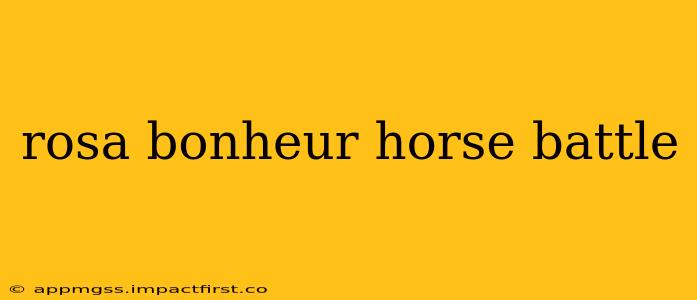Rosa Bonheur, a celebrated 19th-century French painter, is renowned for her breathtaking animal portraits, particularly her majestic depictions of horses. While not exclusively focused on battle scenes, her work often captured the power, energy, and raw emotion of horses, frequently hinting at the intensity of conflict or struggle. This exploration delves into Bonheur's portrayal of horses in combative contexts, examining her techniques and the impact of her work.
What are some of Rosa Bonheur's most famous horse paintings?
Among her most acclaimed works are The Horse Fair (1853), a monumental piece showcasing a bustling horse market teeming with life and energy, and Ploughing in the Nivernais (1849), which vividly portrays the strength and endurance of horses at work. Although not explicitly battle scenes, these paintings demonstrate Bonheur's mastery of capturing equine movement and emotion, elements that could easily be transposed to a battle setting. Her keen observation of animals, combined with her ability to render their musculature and dynamic poses, gives even her non-battle paintings a sense of potential conflict and power. Other works, less famous but equally impressive, showcase similar themes of equine strength and struggle, which arguably foreshadows or mirrors the intensity of a battle.
Did Rosa Bonheur paint any war scenes?
While Bonheur didn't create paintings explicitly titled "battle scenes," many of her works evoke the atmosphere and intensity of conflict. The powerful musculature of her horses, the implied tension in their postures, and the dynamic composition often suggest a struggle, whether it's the struggle against nature's forces or a more direct conflict. Her keen attention to detail, particularly in rendering the horses' expressions and body language, allows the viewer to infer a narrative that goes beyond simple portraiture. The raw energy captured in paintings like The Horse Fair, for instance, could be easily reinterpreted as the chaos and intensity of a battle.
How did Rosa Bonheur depict the power and emotion of horses?
Bonheur's unique approach to depicting horses lies in her meticulous attention to anatomical accuracy and her ability to convey emotion. She spent extensive time studying horses in various environments, meticulously observing their movements and behavior. This deep understanding is evident in her paintings, where the horses are not simply rendered forms but possess a palpable sense of life and character. The way she captures the strain of muscles, the glint in their eyes, and the subtle shifts in their postures all contribute to a powerful and emotive portrayal of these majestic creatures. This mastery of realism enables her to convey the potential for both grace and brutal power, elements central to any depiction of a horse battle.
What techniques did Rosa Bonheur use in her paintings?
Bonheur employed a realist style, emphasizing meticulous detail and accurate representation. She was a master of light and shadow, using these elements to sculpt the forms of her horses and create a sense of depth and movement. Her brushwork is often bold and confident, reflecting the powerful nature of her subjects. She also paid careful attention to the setting, often including landscapes that enhance the overall atmosphere of her paintings. This combination of technical skill and observational precision enabled her to create incredibly lifelike and emotionally resonant representations of horses, whether in peaceful settings or those suggesting potential conflict. This realism is key to understanding the implied intensity of a battle scene even when not explicitly depicted.
What is the legacy of Rosa Bonheur's work?
Rosa Bonheur's legacy extends far beyond her impressive technical skills. She was a pioneering female artist in a male-dominated field, achieving remarkable success despite societal barriers. Her realistic depictions of animals challenged the prevailing artistic conventions of her time, influencing generations of artists who followed. Her work continues to inspire awe and admiration for its beauty, power, and profound understanding of the animal world. The implied intensity of struggle within many of her works, even in non-battle settings, provides a testament to her keen observation and understanding of the raw power and emotion inherent in these magnificent creatures. Her legacy ensures her work remains relevant and compelling, continually prompting viewers to consider the dynamic interplay of power and emotion within the animal kingdom.
